![]()
![]()
![]()
Use LEFT and RIGHT arrow keys to navigate between flashcards;
Use UP and DOWN arrow keys to flip the card;
H to show hint;
A reads text to speech;
23 Cards in this Set
- Front
- Back
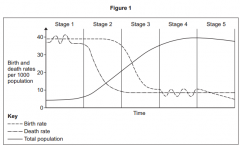
Which stage of the model does the following sentence describe? As the standard of living rises, the birth rate falls rapidly and the death rate remainslow (1) |
Stage 3 |
|
|
Account for the strategies adopted by one EU country to cope with an ageingpopulation (8) |
• In France • the Carte Famille Nombreuse has been introducedwhich gives discounts for families with 3+ children. • This will helpcope with the ageing population because it will encourage anincrease in the number of children who will soon work and thenpay taxes. The government can use these to pay for the costsof the elderly. • Similar is the free nursery fees for the underthrees so that French mothers can go back to work and stillcontribute to the economy and so help fund increased elderlyhealth care costs. The UK is putting the pension age up to 67 or 68 so thegovernment doesn’t have to pay pensions for as long. • Publicsector workers have to pay more into their pensions so thegovernment costs are less. More EU immigrants come to workand pay taxes, this means the government can pay for theelderly |
|

Explain the cartoon’s message about the impacts of migration on the receiving (host)country (4) |
• It isconcerned with the resentment felt by some unemployed aboutmigrants who are working and also that is often the oldergenerations who feel and experience this. • It also suggests thatmigrants may have skills that are lacking in the indigenouspopulation and that they therefore fill gaps in the workforce. |
|
|
Use one or more examples to explain why people migrate within the EU (4) |
•The pound was worth a lot of Polish currency so ordinary jobshere meant a lot of money could be sent home. •When theGreek economy collapsed people went elsewhere in the EU likeFrance to find jobs / healthcare / a higher standard of living. •A high demand in the UK forlabour on farms has meant lots of Eastern Europeans came towork in East Anglia. •Expansion of EU in 2004made migration possible |
|

Describe the changes in population structure (3) |
•The 65+ age group increases steadily andovertakes <15 in 2000. •The working age population declinesfrom 1950 to 2025, then even more rapidly. •The youngdependents proportion declines quite fast from 1975onwards. |
|
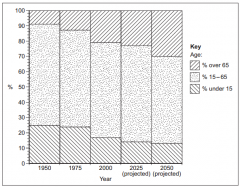
Suggest reasons for the changes in the EU population structure (4) |
• Ageing “baby boomers” creating more retirees now. • More recent decline in births means youth and working ageproportions decline. •Rising life expectancy means morepeople surviving into old age •Lots of people retiringhas reduced the proportion of working age |
|
|
In which stage of the Demographic Transition Model does total population steadilydecline? (1) |
Stage 5 |
|
|
Explain the impact of population decline at this stage of the Demographic TransitionModel (DTM) on economic development (4) |
•EU countries / Scandinavia / Japan •With a smaller working population the government has lessincome from taxes. •This means that it cannot invest in thingssuch as infrastructure that help grow the economy and so itwill suffer as a result. •A smaller working age populationmeans fewer workers •and so potentially lower productivityfrom businesses. |
|
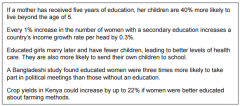
State one benefit to children and one benefit to the community ofeducating women (2) |
Benefit to children: •more likely to live beyond age 5 •willmarry later •better cared for •mortality reduced •more likely togo to school Benefit to community: •higher income growth in country •increased crop yields •higher school enrolment •more likely totake part in political meetings |
|
|
Outline how educating women affects population growth (3) |
•Increased female emancipation •andtherefore freedom to make their own decisions, typicallywomen will then have fewer children. •Better education leadsto better awareness of contraception. •Higher levels ofeducation mean women more likely to go to secondary schooland/or university and/or pursue careers, each of which willdelay age of having first child and reduce total fertility. •Increased wealth as a result which means material things may be placed before having children • falling growth, eg‘fewer children’. |
|
|
Discuss the successes and failures of China’s population policy since the 1990s (8) |
Successes: •rate of population growth significantly slowed(c.1.9% 1950, c.0.7% currently) •the demographic dividend ofan educated and productive workforce aiding rapid economicgrowth •reducing concerns of over-population and resourceimbalance associated with rapid population growth. Failures: •Human rights issues such as late-term and forcedterminations •rapidly ageing population • generation of spoiltchildren • the 4-2-1 problem • gender imbalances andassociated social problems • loss of the burgeoning workforce |
|
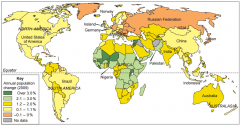
Which continent had the highest rate of annual population change in 2009? (1) |
Africa |
|
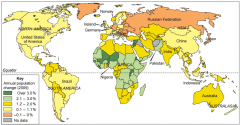
What was the rate of annual population change in Germany in 2009? (1) |
-0.1 – 0% |
|
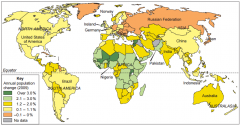
Describe the world pattern of population change (3) |
•The higher rates of increase are generally in the poorer countries(1) •although there are some notable exceptions such as Australiaand Norway (1) •The highest rates of increase are in Sub-SaharanAfrica / Central Africa (1) •The majority of the developed / richercountries have low or negative rates of growth (1) •Eastern Europeand Russia is the largest area of negative population growth /population decline (1) •There are some examples of negativegrowth in the poorer parts e.g. Cuba /Guyana (1). |
|
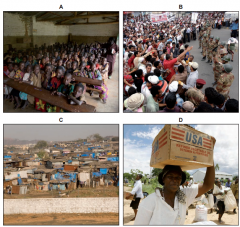
Choose one or more of the results of rapid population growth shown in Figure 2,or others that you have studied. Outline how your chosen result(s) can be caused by rapid population growth (4) |
•With a fast increasing population it is harder for the government toprovide enough schools to cope with large numbers of children. •The population grows faster than the amount of food they can growso there are food shortages. |
|
|
Explain how a non birth control policy can help achieve sustainable development (8) |
•Education programmes in Kerala mean that literacy rates are now97% and many women go to university. •This means that they alsocontribute to the economy and help the country to develop. •They are also less likely to have many children as they will want acareer. •This helps development as there will be fewer children forthe country to provide for. •Land reform makes the countrysidemore productive. •It will be less of a subsistence economy. •Thisalso means that fewer people will migrate to the cities and there willbe less strain on resources and infrastructure to cope with them inshanty towns. |
|
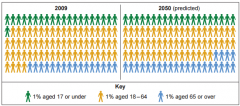
Describe the changes in the UK population structure (4) |
•There is predicted to be a 50% (accept 8%) increase in thepercentage of elderly / over 65 by 2050. •Only just over half thepopulation will be of working age in 2050. •Smaller percentage of children in 2050. |
|
|
The following is a list of some problems linked to an ageing population: 1. More healthcare services are needed 2. Fewer people are paying taxes 3. More pensions need to be paid. •Choose two of the problems listed, or others that you have studied. •Explain how each of your chosen problems can affect the future economic developmentof a country (4) |
More healthcare services needed: • money needs to be spent onlooking after the elderly • this increases the cost so money cannot bespent on other things such as infrastructure. •There is less moneyavailable for things such as schools and universities so the skills ofthe population and their ability to earn are reduced. Fewer people paying taxes: • this reduces the income for thegovernment so it cannot invest / spend on things which will help theeconomy. More pensions need to be paid: •this becomes an increasingburden and has no benefit to the economy. • many companies havehuge debts because of their pension commitments and so will gobankrupt, harming economic growth. |
|
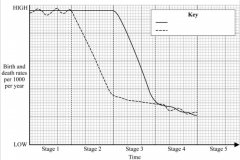
What is the name of the model shown (1) |
Demographic Transition (Model) (1) |
|
|
Explain how and why the natural increase of population changes inStage 2 of the DTM (4) |
•The birth rate remains high because there is little use of contraception •butimprovements in medicine lead to a decline in the death rate. •The rate ofnatural increase gets larger as the difference between the birth and thedeath rates get larger. |
|
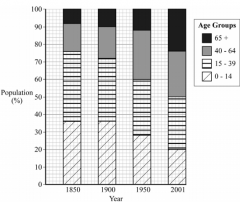
What percentage of the population was aged between 40 and 64 in 1950? (1) |
28(%) |
|
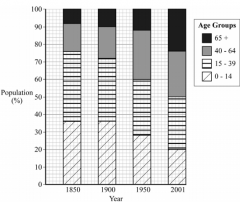
Give two reasons for the changes in the population of Sweden after 1850 (2) |
•People are living longer so more older people. •Birth rate drops. •Fewerpeople of childbearing age. •More contraception available. |
|
|
Describe how governments of richer countries have tried to cope withchanges in population structure (8) |
•Increase the workforce by encouraging the immigration of young adultsfrom poorer countries. •Giving financial rewards to have more childrensuch as in Italy and France. •Raise the retirement age so people staylonger in work, continuing to pay taxes and so receive pensions for ashorter time. •Make those in work pay higher taxes to pay the higherpensions and greater social security. •Abolish state pensions and makepeople pay for their own pensions. |

